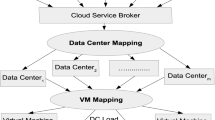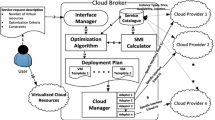Abstract
A cloud computing platform provides access to shared resources along with diverse services including computation and storage to its users. The ubiquitous access to resources requires the service providers to ensure an efficient, reliable, and a fault-tolerant infrastructure. In this context, the cloud brokering mechanisms enable the cloud computing platforms to manage cloud resources through mediation between cloud service providers and cloud users. Corresponding to user requests, the cloud service brokering and load balancing aim at efficient real-time provision of services with minimal monetary cost through selection of appropriate data centers and virtual machines. This paper proposes a normalization-based hybrid service brokering approach integrated with throttled round-robin load balancing to improve resource management through cost- and performance-aware provision of cloud services. The proposed approach incorporates a hybrid (static and dynamic) evaluation criteria using normalization for determining the impact of cost and performance-oriented parameters in a multi-cloud environment. The subsequent selection of the most appropriate service provider along with throttled round-robin load balancing optimizes cloud resource management. The experiments performed with diverse number of user bases and data centers show that the proposed cloud service brokering approach outperforms other well-known approaches by improving response time, data center processing time, and monetary cost up to 17.39%, 31.35%, and 7.06%, respectively.











Similar content being viewed by others
Notes
To be customized by user.
References
Buyya R (2009) Market-oriented cloud computing: vision, hype, and reality of delivering computing as the 5th utility. In: 2009 9th IEEE/ACM International Symposium on Cluster Computing and the Grid. pp 1–1
Rak M, Cuomo A, Villano U (2013) Cost/performance evaluation for cloud applications using simulation. In: 2013 Workshops on Enabling Technologies: Infrastructure for Collaborative Enterprises, pp 152–157
Gibson J, Rondeau R, Eveleigh D, Tan Q (2012) Benefits and challenges of three cloud computing service models. In: 2012 Fourth International Conference on Computational Aspects of Social Networks (CASoN), pp 198–205
Kondo D, Javadi B, Malecot P, Cappello F, Anderson DP (2009) Cost-benefit analysis of cloud computing versus desktop grids. In: 2009 IEEE International Symposium on Parallel Distributed Processing, pp 1–12
Fareghzadeh N, Seyyedi MA, Mohsenzadeh M (2019) Toward holistic performance management in clouds: taxonomy, challenges and opportunities. J Supercomput 75(1):272–313
Bossche RV, Vanmechelen K, Broeckhove J (2010) Cost-optimal scheduling in hybrid IAAS clouds for deadline constrained workloads. In: 2010 IEEE 3rd International Conference on Cloud Computing, pp 228–235
Priya V, Kumar CS, Kannan R (2019) Resource scheduling algorithm with load balancing for cloud service provisioning. Appl Soft Comput 76:416–424
Monika JA (2018) Optimized task scheduling algorithm for cloud computing. In: Mishra DK, Nayak MK, Joshi A (eds) Information and communication technology for sustainable development. Springer, Singapore, pp 431–439
Hu J, Gu J, Sun G, Zhao, T (2010) A scheduling strategy on load balancing of virtual machine resources in cloud computing environment. In: 2010 3rd International Symposium on Parallel Architectures, Algorithms and Programming, pp 89–96
Assuncao MD, Buyya R (2009) Performance analysis of allocation policies for intergrid resource provisioning. Inf Softw Technol 51(1):42–55
Malawski M, Juve G, Deelman E, Nabrzyski J (2015) Algorithms for cost- and deadline-constrained provisioning for scientific workflow ensembles in iaas clouds. Fut Gen. Comput Syst 48(C):1–18
Heilig L, Lalla-Ruiz E, VoB S (2016) A cloud brokerage approach for solving the resource management problem in multi-cloud environments. Comput Ind Eng 95:16–26
Lucas-Simarro JL, Moreno-Vozmediano R, Montero RS, Llorente IM (2013) Scheduling strategies for optimal service deployment across multiple clouds. Fut Gen Comput Syst 29(6):1431–1441
Tordsson J, Montero RS, Moreno-Vozmediano R, Llorente IM (2012) Cloud brokering mechanisms for optimized placement of virtual machines across multiple providers. Fut Gen Comput Syst 28(2):358–367
Arya D, Dave M (2017) Priority based service broker policy for fog computing environment. In: Singh D, Raman B, Luhach AK, Lingras P (eds) Advanced informatics for computing research. Springer, Singapore, pp 84–93
Jain R, Sharma N, Sharma T (2018) Enhancement in performance of service broker algorithm using fuzzy rules. In: 2018 2nd International Conference on Inventive Systems and Control (ICISC), pp 922–925
Breitgand D, Maraschini A, Tordsson J (2011) Policy-driven service placement optimization in federated clouds. Computer Science, IBM Research Division, Technical report, pp 1–11
L D DB, Krishna PV (2013) Honey bee behavior inspired load balancing of tasks in cloud computing environments. Appl Soft Comput 13(5):2292–2303
Ahmad MO, Khan RZ (2018) Load balancing tools and techniques in cloud computing: a systematic review. In: Bhatia SK, Mishra KK, Tiwari S, Singh VK (eds) Advances in computer and computational sciences. Springer, Singapore, pp 181–195
Leal K, Huedo E, Llorente IM (2009) A decentralized model for scheduling independent tasks in federated grids. Fut Gen Comput Syst 25(8):840–852
Manasrah AM, Aldomi A, Gupta BB (2017) An optimized service broker routing policy based on differential evolution algorithm in fog/cloud environment. Clust Comput 22:1639–1653
Wang SC, Yan K, Liao WP, Wang SS (2010) Towards a load balancing in a three-level cloud computing network. In: 2010 3rd International Conference on Computer Science and Information Technology, vol 1, pp 108–113
Acharya S, D’Mello DA (2017) Energy and cost efficient dynamic load balancing mechanism for resource provisioning in cloud computing. Int J Appl Eng Resea 12(24):15782–15790
Florence AP, Shanthi V (2014) A load balancing model using firefly algorithm in cloud computing. J Comput Sci 10(7):1156
Quarati A, D’Agostino D (2017) Moea-based brokering for hybrid clouds. In: 2017 International Conference on High Performance Computing Simulation (HPCS), pp 611–618
Kessaci Y, Melab N, Talbi E (2013) A pareto-based genetic algorithm for optimized assignment of VM requests on a cloud brokering environment. In: 2013 IEEE Congress on Evolutionary Computation, pp 2496–2503
Chaisiri S, Lee BS, Niyato D (2009) Optimal virtual machine placement across multiple cloud providers. In: 2009 IEEE Asia-Pacific Services Computing Conference (APSCC), pp 103–110
Naha RK, Othman M (2016) Cost-aware service brokering and performance sentient load balancing algorithms in the cloud. J Netw Comput Appl 75(C):47–57
Rodero I, Guim F, Corbalan J, Fong L, Sadjadi SM (2010) Grid broker selection strategies using aggregated resource information. Fut Gen Comput Syst 26(1):72–86
Vecchiola C, Calheiros RN, Karunamoorthy D, Buyya R (2012) Deadline-driven provisioning of resources for scientific applications in hybrid clouds with aneka. Fut Gen Comput Syst 28(1):58–65
Wickremasinghe B, Calheiros RN, Buyya R (2010) CloudAnalyst: a cloudsim-based visual modeller for analysing cloud computing environments and applications. In: 2010 24th IEEE International Conference on Advanced Information Networking and Applications, pp 446–452
Rekha PM, Dakshayini M (2018) Dynamic cost-load aware service broker load balancing in virtualization environment. Procedia Comput Sci 132:744–751. (International Conference on Computational Intelligence and Data Science)
Jaikar A, Noh SY (2015) Cost and performance effective data center selection system for scientific federated cloud. Peer to Peer Netw Appl 8(5):896–902
Mishra RK, Kumar S, Naik BS (2014) Priority based round-robin service broker algorithm for cloud-analyst. In: 2014 IEEE International Advance Computing Conference (IACC), pp 878–881
Radi M (2014) Weighted round robin policy for service brokers in a cloud environment. In: The International Arab Conference on Information Technology (ACIT2014), Nizwa, Oman, pp 45–49
Coello CAC, Lamont GB, Veldhuizen DAV (2006) Evolutionary algorithms for solving multi-objective problems (genetic and evolutionary computation). Springer, Berlin
Conforti M, Cornuejols G, Zambelli G (2014) Integer programming. Springer, Berlin
Li X, Ma H, Zhou F, Yao W (2015) T-broker: a trust-aware service brokering scheme for multiple cloud collaborative services. IEEE Trans Inf Forensics Secur 10(7):1402–1415
Jrad F, Tao J, Streit A (2012) Simulation-based evaluation of an intercloud service broker. In: The Third International Conference on Cloud Computing, Grids, and Virtualization, pp 140–145
Calheiros RN, Ranjan R, Beloglazov A, De Rose CAF, Buyya R (2011) Cloudsim: a toolkit for modeling and simulation of cloud computing environments and evaluation of resource provisioning algorithms. Softw Pract Exp 41(1):23–50
Kishor K, Thapar V (2014) An efficient service broker policy for cloud computing environment. Int J Comput Sci Trends Technol 2(4):104–109
Kapgate D (2014) Efficient service broker algorithm for data center selection in cloud computing. Int J Comput Sci Mob Comput 3(1):355–65
Sharma V (2014) Efficient data center selection policy for service proximity service broker in cloudanalyst. Int J Innov Comput Sci Eng 1(2):21–28
Author information
Authors and Affiliations
Corresponding author
Additional information
Publisher's Note
Springer Nature remains neutral with regard to jurisdictional claims in published maps and institutional affiliations.
Rights and permissions
About this article
Cite this article
Khan, M.A. Optimized hybrid service brokering for multi-cloud architectures. J Supercomput 76, 666–687 (2020). https://doi.org/10.1007/s11227-019-03048-5
Published:
Issue Date:
DOI: https://doi.org/10.1007/s11227-019-03048-5




